-
PDF
- Split View
-
Views
-
Cite
Cite
D. R. Xiong, L. Deng, C. Zhang, Turbulent convection and pulsation stability of stars – I. Basic equations for calculations of stellar structure and oscillations, Monthly Notices of the Royal Astronomical Society, Volume 451, Issue 3, 11 August 2015, Pages 3354–3365, https://doi.org/10.1093/mnras/stv1170
Close - Share Icon Share
ABSTRACT
Starting from hydrodynamic equations, we have established a set of hydrodynamic equations for average flow and a set of dynamic equations of auto- and cross-correlations of turbulent velocity and temperature fluctuations, following the classic Reynold's treatment of turbulence. The combination of the two sets of equations leads to a complete and self-consistent mathematical expressions ready for the calculations of stellar structure and oscillations. In this paper, non-locality and anisotropy of turbulent convection are concisely presented, together with defining and calibrating of the three convection parameters (c1, c2 and c3) included in the algorithm. With the non-local theory of convection, the structure of the convective envelope and the major characteristics of non-adiabatic linear oscillations are demonstrated by numerical solutions. Great effort has been exercised to the choice of convection parameters and pulsation instabilities of the models, the results of which show that within large ranges of all three parameters (c1, c2 and c3) the main properties of pulsation stability keep unchanged.
1 INTRODUCTION
Great advances in understanding the pulsation of variable stars have been achieved thanks to continuous work by generations of researchers for over five decades. Among others, we would like to name three classical books by Ledoux & Walraven (1958), Cox (1980) and Unno et al. (1989) which reviewed and concluded exclusively the major research work done in that period of time. The theory of stellar pulsations reached a state of art stage that makes the field probably one of the bests in astrophysics. Nevertheless, some of the fundamental questions remain. Convection inside the pulsators is one of the most difficult and long-standing problems. Revolutionary observations from space by CoRoT and Kepler spaces missions, in terms of both accuracy (down to micromagnitude) and uninterrupted time baseline (up to months), mark a new era in stellar variability studies. Thousands of small amplitude variables of many different types are discovered, which would be otherwise undetectable with ground-based instruments. Such great discovery capability greatly enhanced observations of stellar variability from δ Scuti, γ Doradus on the main sequence (MS) to pulsating red giants. Such observations provide not only opportunities but also challenges in this field, because convection replaces radiation becoming the major energy transport mechanism in stars with very extended convective envelope. As a result, dealing with the coupling between convection and oscillations is a key factor for understanding variables with low surface temperatures. However, the treatment of stellar convection, so called mixing-length theory (MLT), developed by Böhm-Vitense (1958) in the middle of last century is still the most popularly used in the calculations of stellar structure, evolution and oscillations. Modified versions such as time-dependent MLT (Unno 1967; Gough 1977; Stellingwerf 1982; Grigahcène et al. 2005), and non-local MLT (Spiegel 1963; Ulrich 1970) had then been made in order to account for oscillations of variable stars. Needless to say that we are still far from fully understanding the nature and principal properties of stellar turbulence, therefore a robust theory of stellar convection is still missing in the community. This led to the fact that the results cannot converge for the same observational problems when different treatments of convection were used. The theory of convection is still the most uncertain factor that prevents us from clear understandings of oscillations in low-temperature stars. In this series of papers, we are going to apply the non-local and time-dependent theory of convection we developed to the calculations of stellar oscillations. In order to cope with the great advances in observations of small amplitude red variable stars resulted from recent missions, a systematic theoretical calculations of δ Scuti, γ Doradus and pulsating red giants are carried out, in which convection is treated by our non-local and time-dependent theory of turbulent convection. The theory was started more than 30 yr ago, and has been in continuous improvements since then. Our study shows that anisotropy of turbulent convection has important effects on stellar oscillations. In the case of non-radial oscillations, neglecting anisotropy means turbulent viscosity is disregarded at the same time. Therefore, the red edge of the instability strip of δ Scuti and γ Doradus stars cannot be determined correctly. In Section 2, we give a new complete version of non-local and anisotropic time-dependent convection theory and a new uniform expression for turbulent dissipation and diffusion. In Section 3, we will show the general properties of the structure of stellar non-local convective envelopes. The results of theoretical calculations of non-adiabatic linear oscillations of stars are presented in Section 4 along with the dependence of pulsation stability on the selection of convection parameters. Conclusions and discussions are given in the last section of this paper.
2 THE BASIC EQUATIONS
2.1 The average hydrodynamic equations
The average form of hydrodynamic equations (equations 7–11) is similar as their original form (equations 1–5). When convection sets in, however, an extra term, |$\overline{\rho u^{\prime i}u^{\prime k}}$| emerges in the average equation of momentum conservation (equation 7), which is nothing but the well-known Reynold's stress. And another extra term, |$\bar{\rho }{\bar{C}}_P\bar{T}\overline{w^{\prime k}T^{\prime }/\bar{T}}$| appears in the equation of energy conservation (equation 9), which is convective enthalpy flux. These two terms represent, respectively, momentum and thermal energy transport caused by convection in the fluid. The next step in our theory is to formulate the dynamic equations for these terms. Once the dynamic equations of the second-order correlation of turbulent velocity and temperature are established, the whole set of dynamic equations of turbulent convection becomes solvable by combination of resulted equations with those of averaged dynamic equations (equations 7–11).
2.2 Dynamic equations of turbulent velocity and temperature
2.3 Dynamic equations of correlations of turbulent velocity and temperature
Convection is an intrinsic instability induced by thermal instability in fluid. Equations (15)–(17) are the dynamic equations describing the auto- and cross-correlations of turbulent velocity and temperature in stars. Taking equation (15) as an example, it can be regarded as the conservation of turbulent kinetic energy, the first term in which represents the variation rate of turbulent kinetic energy, therefore is the sum of all the other terms with a negative sign, while the second and the third terms are the exchange rates between the average kinetic energy and turbulent energy due to the shear force of average motion of the fluid; the fifth and sixth terms are the variation rates of turbulent kinetic energy caused by buoyancy force; the fourth term is the pure gain of turbulent kinetic energy due to momentum exchange of non-local turbulent kinetic energy flux (defined as |$\overline{\rho u^{\prime k}w^{\prime i}w^{\prime j}}$|); the brackets in the seventh term are the pressure tensor flux and viscous tensor flux; the last two terms in the left-hand side and the terms in the right-hand side in equation (15) will be discussed in detail later.
2.4 Turbulent dissipation
Non-locality and anisotropy of turbulence are the most fundamental and important properties of stellar convection, both of which play key roles in stellar evolution and pulsation instability and will be discussed in Sections 2.5 and 2.6.
2.5 Non-locality of turbulent convection
The original MLT (Böhm-Vitense 1958) is a phenomenological and local expression of stellar convection. As pointed out by Spiegel (1963), the local MLT would make sense only when convective motion were homogeneous in an infinitely large field, or when the so called mixing-length was far smaller than the characteristic dimension of fluid media. Unfortunately, these two length-scales are usually comparable in stellar interiors, and the temperature gradient generally changes considerably within a mixing-length in stellar fluid media. To overcome such a shortcoming, one can replace the local temperature gradient at a given point in the fluid by the averaged value over a mixing-length (Spiegel 1963). In such a way, the general treatment of convection became a non-local MLT.
Another way of closure of the correlation equations is to formulate the dynamic equations of the third-order terms, and to deal with the fourth-order correlations that emerge in the process. Following the theory of stochastic processes, a fourth-order correlation can be represented by the product of two second-order correlations, given the stochastic quantities obey Gaussian distribution. Grossman (1996) made a very thorough comparison between the two ways of closure, and he concluded that for the second-order correlations, the former algorithm (equations 23–25) is more preferable. For the calculations of stellar structure and oscillations, the second-order correlations are more important. For that reason, he further pointed out that the closure we offered is also more practical.
2.6 Anisotropy of turbulent convection
Now, equations (33)–(41) form a complete set of dynamic equations for the calculation of stellar structure and oscillations.
2.7 Calibrations of convective parameters c1, c2 and c3
After proper treatment for turbulent dissipation, diffusion and anisotropy, the original equations (15)–(17) have been transformed to the dynamic equations of non-local and anisotropic convection (38)–(41). Three parameters (c1, c2 and c3) are included during parametrization of turbulent dissipation (equations 18–20), turbulent diffusion (equations 23–25) and anisotropy of turbulent convection (equation 30). They should be a function varying slowly with mass M, luminosity L, and effective temperature Te of stars (Ludwig, Freytag & Steffen 1999). To date, the most reliable way for the calibrations of parameters introduced in different types of convection theories is on the basis of the Sun. Limited observational constraints can hardly calibrate separately the three parameters in our theory. c3 is rather an independent parameter which can, in principle, be calibrated using the variations of radial and horizontal turbulent velocity and temperature as functions of depth in solar outer layers. Unfortunately, observations capable of doing such a calibration are not yet accurate enough to ensure good calibrations of c3. From stellar evolution point of view, c3 is more linked to the structure of convective overshooting zones in stars. There is convergent evidence from observations of solar granulation velocity, hydrodynamic simulations and numerical calculations using our non-local and anisotropic convection theory, that are all inclined to the same conclusion: turbulent motion is primarily radial in convectively unstable zone, while it becomes more and more dominant in horizontal motion when going into overshooting region. The major function of anisotropy of turbulence there is to reduce the depth of overshooting distance. Fortunately, the ratio of the radial and horizontal components (|$u^{\prime }_r$| and |$u^{\prime }_h$|) of turbulent velocity is approximately |$\overline{u^{\prime 2}_r}/\overline{u^{\prime 2}_h}\approx 1/2$| in convective overshooting zone, which is almost independent of the choice of c3. Many studies, including observations of the velocity field of solar granulations, hydrodynamic simulations (Deng et al. 2006) and calculations of lithium abundance profile in the Sun and stars (Xiong & Deng 2009), show that c3 ≈ 3 is a plausible value. That infers that |$\overline{u^{\prime 2}_r}/\overline{u^{\prime 2}_h}\approx 1$| in the convectively unstable zone, and it is also in good agreement with the most unstable modes from linear oscillation stability analysis of convective modes (Unno 1961).
As c1 and c2 are the two convection parameters that represent the characteristic lengths le and Λ of turbulence (equations 31 and 32), therefore it is reasonable to believe that the ratio of the two parameters c2/c1 should be close to a constant of order unity. As a result, once c3 and c2/c1 are fixed, c1 becomes the only one adjustable parameter in the mathematical scheme of our theory.
Based on systematic analysis of all the results from observations of the velocity field of solar granulations (Keil & Canfield 1978; Nesis & Mattig 1989; Komm, Mattig & Nesis 1991), assessment of the surface lithium abundance in late-type dwarf stars, using hydrodynamic simulations, and the comparison between adiabatic helioseismic inversion and the theoretical models (Zhang et al. 2012), we have come to a set of parameters (c1, c2/c1, c3) = (0.64, 0.50, 3) that is robust in dealing with stellar convection.
2.8 A comparison with our previous models
Convection interacts with the stability of stellar oscillations through convective energy transfer (thermodynamic coupling between convection and oscillations), turbulent pressure and turbulent viscosity (dynamic coupling between convection and oscillations). The non-locality and anisotropy of turbulent convection are the two important and yet very difficult issues in this study. The current paper delivers for the first time straightforward and concise explanations to three properties of stellar convection, namely turbulent dissipation, diffusion and anisotropy. Also for the first, we give unified presentations for turbulent dissipation and diffusion: equations (18)–(20) and (23)–(25). Compared with our previous work (Xiong 1989; Xiong et al. 1997), minor modifications has been made to the coefficients in the equations of turbulent dissipation, which affects only the choice of convection parameters. The expressions of turbulent diffusion, however, has been changed substantially. In our previous work, diffusion coefficient is a scalar, therefore turbulent diffusion in that case was isotropic. In the current work, in equations (23)–(25), the diffusion coefficient is a second-order tensor, which facilitates more realistic assessments of turbulent diffusion: in convectively unstable zone, turbulent diffusion along the radial direction is stronger than in the horizontal directions; in the overshooting zone, however, the strength as a function of directions reversed. Such a change will alter the structures of convective and overshooting zones significantly. For the same set of convection parameters (c1, c2, c3), the depth of convectively unstable zone is deeper, and the overshooting zones both become shallower in the new expressions of turbulent diffusion in the current work compared with our previous work. In short, our previous work overestimated overshooting mixing, in that the convective parameter c2 describing turbulent diffusion had to be reduced to 1/4–1/8 of c1 in order to slow down the lithium depletion in solar atmosphere (Xiong & Deng 2002). That was, of course, not physically appropriate. When the new expressions of turbulent diffusion, equations (23)–(25), and the calibrated parameter set (c1, c2, c3) are incorporated, the results on the structure of solar convective zone and solar lithium abundance that in good agreement with observations can all be achieved. In a forth coming paper in this series, we will present models and discussions on turbulent anisotropy and its connections with pulsation instabilities.
3 THE STRUCTURE OF CONVECTIVE ENVELOPE OF STARS
Then, inserting equation (47) into (33), equation (37) can be eliminated. φ not anymore shows up in equations (33)–(36) and (38)–(41). In such a way, the whole equations degrade two orders. The number of equations for equilibrium envelope structure is now 12. For the boundary conditions and numerical scheme of working equations in non-local convection, please refer to our previous work (Deng & Xiong 2008). It is emphasized here that convective envelope structure in local condition is only an initial value problem of solving the fourth-order differential equations, which can be integrated from stellar surface down to the bottom of convective zone. However, for non-local treatment, solutions of the set of equations of correlations (38)–(41) become non-trivial, which is a set of 4 (anisotropic convection) or 3 (isotropic approximation) second-order differential equations, and boundary conditions at both the surface and bottom of convective zone will be needed. Therefore, for non-local convection, it is to solve for boundary value problem of a set of 12 (anisotropic) or 10 (isotropic) equations. In our practice, Henyey method (Henyey, Forbes & Gould 1964) has been adopted to integrate the equations. Fig. 1 presents the autocorrelations of turbulent velocity and temperature fluctuations x2 and Z, and their cross-correlation V as functions of logarithmic gas pressure log P, for non-local solar convective envelope in approximation of isotropic convection (the dashed lines) and the corresponding local model (the dotted lines) having the same depth of convective zone. As shown in Fig. 1, both local and non-local models have virtually the same x, Z and V within the convectively unstable zone, revealing the fact that local convection theory is rather a very good first-order approximation. However, the two cases have distinct behaviours outside the convectively unstable region. Convective motions under local treatment are suddenly halted at the boundaries, while that in non-local theory x, Z and V reduce as a power law of P in the overshooting zone just as expected as convective overshooting in the theory. Such a predicted trend has been proved by observations of the velocity and temperature fields of solar atmospheres, and also verified by hydrodynamic simulations (Deng et al. 2006).
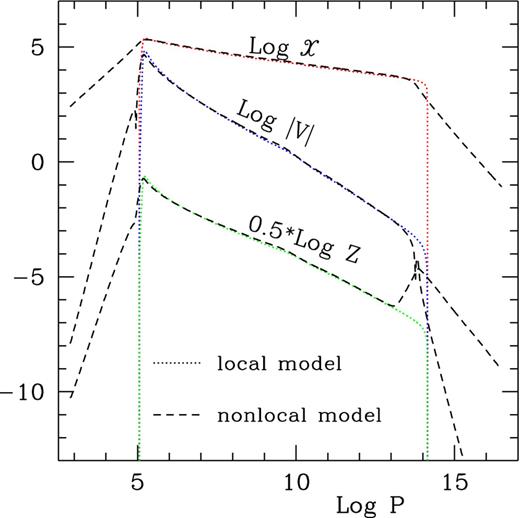
The correlations x, Z, V of turbulent velocity and temperatures versus log P for the local (dotted lines) and non-local (dashed lines) models of the Sun.
Convective motion properties shown in Fig. 1 actually represent general properties of the turbulent velocity and temperature fields of low-temperature stars with extended convective envelopes. For stars of somewhat higher temperatures, however, the structure of turbulent velocity and temperature fields becomes very different for the local and non-local convection models. Fig. 2 depicts the same quantities describing turbulent motions as in Fig. 1 but for a warm δ Scuti star (M = 1.8 Mȯ, log L/Lȯ = 1.1844, log Te = 3.8604), the dotted lines are for local models, and dashed lines for non-local. Also presented is the fractional radiation flux Lr/L as a function of depth in terms of log P. In Fig. 2, horizontal bars denote, respectively, the partially ionized (5–95 per cent) zones of ionized hydrogen (H+), the first and second ionized helium (He+, He++). It is clear from Fig. 2 that, in the local model the second ionized helium convective zone is completely detached from those of the ionized hydrogen, first ionized helium, and Fe-absorption peak; whereas they are connected and form a single and larger convective zone in the non-local model due to overshooting from the zones. Such results enable plausible explanations to problems such as lithium depletions in the Sun and F-type stars, chemical abundance abnormals in the atmospheres of Ap stars, as well as stellar oscillation stabilities in general.
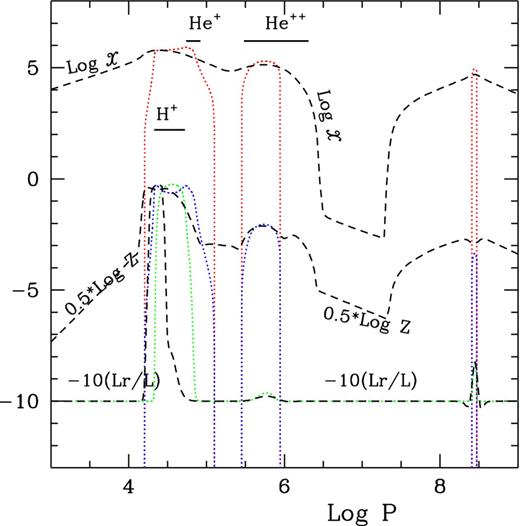
log x, log Z, and −10(Lr/L) versus log P for a model of δ Scuti star (M = 1.8 Mȯ, log L/Lȯ = 1.1844 and log Te = 3.8604) calculated using local (dotted lines) and non-local (dashed lines) treatment.
Diffusion induced by radiative acceleration and gravitational settling are usually adopted for the abundance anomaly for Ap stars (Richer & Michaud 1993; Michaud & Beaudet 1995). However, the diffusion time-scale is too short in hot stars like Aps that have too thin convective zones. In this regard, some unknown turbulent diffusion enforcing an inverse mixing to extend the time-scale (Richard, Michaud & Richer 2005). By applying our non-local convection theory in handling such a process, as demonstrated in Fig. 2, the convective region in these hot stars is largely extended due to non-local convective diffusion. As a result, the diffusion time-scale is naturally extended, therefore the manually added unknown turbulent diffusion is not any more needed.
We have also calculated lithium depletion in late-type dwarfs (Xiong & Deng 2009) using the same theory and parameter set, the results are presented in Fig. 3. Two isochrones of age 0.4 and 0.7 Gyr were presented calibrated by using the Sun, the solid lines are models with gravitational settling, while the dotted lines without settling. The solid dot, circle and square symbols in Fig. 3 represent, respectively, the observed atmospheric lithium abundance of member stars in three intermediate age open clusters, Coma (0.4–0.5 Gyr), Hyades and Praesepe (0.6–0.7 Gyr), the solid and empty triangles are the upper limits of lithium abundance from observations. Our theoretical predictions (the solid lines) agree pretty well with observational data in the three clusters. Towards the low-temperature side, the depletion increases due to deepening of convective zone and more extended overshooting zone for lower temperatures; whereas at the high-temperature end, higher depletions are caused by shorter gravitational settling time-scale in stars with shallower convective zones. Presumably, our theory is also able to deal with abundance anomaly in Ap stars by implementing radiative acceleration in the scheme.
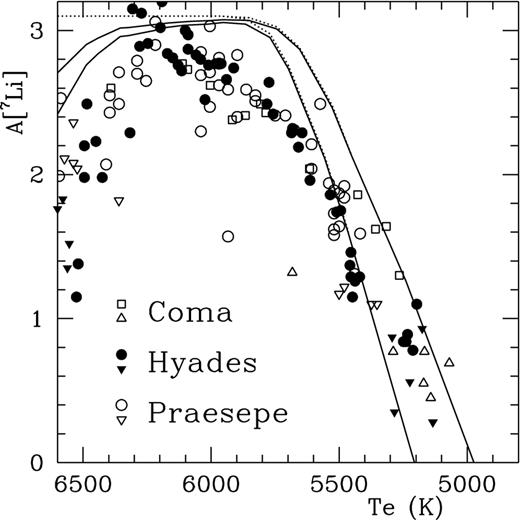
Lithium abundance versus effective temperature for late-type dwarfs in Galactic open clusters Coma (of age 0.4–0.5 Gyr), Hyades and Prasepe (0.6–0.7 Gyr). The solid and empty triangles represent the upper limits. The two solid lines are the theoretical isochrones at the ages of 0.4 and 0.7 Gyr, respectively.
Using isotropic and non-local convection theory, together with the quasi-anisotropic approximation in equation (48), we have the numerical scheme of quasi-anisotropic and non-local convection ready for stellar models. Fig. 5 gives the correlations of turbulent velocity and temperature fluctuations x2, Z, V and χ11 as functions of depth (log P) of quasi-isotropic (the dotted lines) and anisotropic (dashed lines) models of the Sun. It is clearly shown in Figs 4 and 5 that, in terms of not only the T − P structure, but also turbulent velocity and temperature fields, the quasi-anisotropic and the full anisotropic models nearly resemble each other. In practice, isotropic modelling are far better in terms of convergence and stability in the computation than full anisotropic treatment. Taking such an advantage, we usually consider quasi-anisotropic model as a good replacement of the full anisotropic one for the calculations the equilibrium models. As we will show in Section 4, the results of oscillation models based on the two approaches are nearly identical.
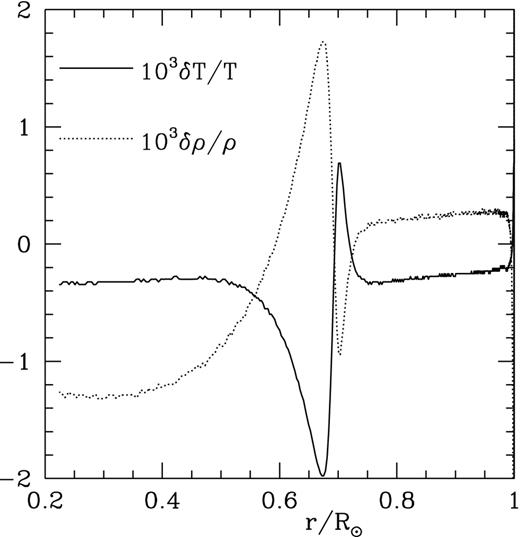
The relative difference in temperature and density (δT/T and δρ/ρ) between the anisotropic and isotropic convection models as functions of fractional radius r/Rȯ.
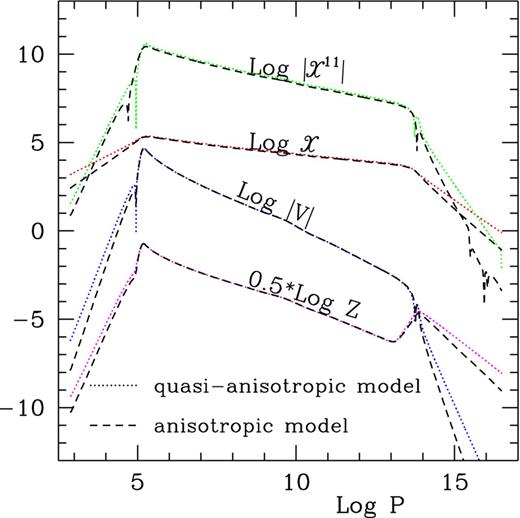
log x, log Z, log |V| and log χ11 versus log P for the anisotropic (dashed lines) and quasi-anisotropic (dotted lines) convection models of the Sun.
4 NON-ADIABATIC OSCILLATIONS OF STARS
4.1 Radial and non-radial non-adiabatic oscillations of stars
However, for non-radial oscillations of stars, equation (50) does not hold. It is extremely difficult to handle χij in a precise way. Fortunately, apart from the central most parts, nearly all oscillations in the outer layers of stars oscillate dominantly in the radial direction (Unno et al. 1989), therefore equations (50) and (51) still hold approximately and χij has only one independent component. Given such conditions, the order of the full set of equations for non-radial oscillations becomes 16.
Using the stellar evolutionary code from Padova group (Bressan et al. 1993), we calculated totally 14 evolutionary sequences for stellar mass M = 0.6–3.0 Mȯ with the solar abundance (X = 0.70, Z = 0.02) and an intermediate overshooting (lover = 0.5HP). Taking luminosities and effective temperatures (log L/Lȯ, log Te) along the evolutionary tracks, we calculated six series of models of convective envelope, using working equations presented in previous section. Where series ‘a’ is that of the completely non-local and anisotropic convection models, whereas series ‘b–f’ are all for quasi-anisotropic convection models. In series ‘b–f’, non-local and isotropic convection models are calculated a prior, then the anisotropic component of turbulence, χ11, is derived using the quasi-anisotropic approximation equation (48). The parameters used for all six series of models are given in Table 1, in which the first column is the series number, the second column shows how the models are calculated: C.A. for completely anisotropic, Q.A. for quasi-anisotropic, and the third to fifth columns give the convection parameters used in the calculations of the corresponding series.
| Series . | Type . | c1 . | c2 . | c3 . |
|---|---|---|---|---|
| a | C.A. | 0.64 | 0.32 | 3 |
| b | Q.A. | 0.70 | 0.35 | 3 |
| c | Q.A. | 0.60 | 0.30 | 3 |
| d | Q.A. | 0.78 | 0.39 | 3 |
| e | Q.A. | 0.70 | 0.35 | 2 |
| f | Q.A. | 0.70 | 0.35 | 5 |
| Series . | Type . | c1 . | c2 . | c3 . |
|---|---|---|---|---|
| a | C.A. | 0.64 | 0.32 | 3 |
| b | Q.A. | 0.70 | 0.35 | 3 |
| c | Q.A. | 0.60 | 0.30 | 3 |
| d | Q.A. | 0.78 | 0.39 | 3 |
| e | Q.A. | 0.70 | 0.35 | 2 |
| f | Q.A. | 0.70 | 0.35 | 5 |
| Series . | Type . | c1 . | c2 . | c3 . |
|---|---|---|---|---|
| a | C.A. | 0.64 | 0.32 | 3 |
| b | Q.A. | 0.70 | 0.35 | 3 |
| c | Q.A. | 0.60 | 0.30 | 3 |
| d | Q.A. | 0.78 | 0.39 | 3 |
| e | Q.A. | 0.70 | 0.35 | 2 |
| f | Q.A. | 0.70 | 0.35 | 5 |
| Series . | Type . | c1 . | c2 . | c3 . |
|---|---|---|---|---|
| a | C.A. | 0.64 | 0.32 | 3 |
| b | Q.A. | 0.70 | 0.35 | 3 |
| c | Q.A. | 0.60 | 0.30 | 3 |
| d | Q.A. | 0.78 | 0.39 | 3 |
| e | Q.A. | 0.70 | 0.35 | 2 |
| f | Q.A. | 0.70 | 0.35 | 5 |
Given the parameters of the series, we calculated non-adiabatic oscillations in low-degree (l = 1–4) g9–p29 modes for series ‘a–f’ defined in Table 1. All the pulsationally stable and unstable modes (F–p4) of series ‘a’ and ‘b’ are presented in Figs 6(a) and (b), where the circles, triangles, inverse triangles and plus signs are used to denote unstable (F–p4) modes, all stable modes are in small dots. From Fig. 6, one can make it clear that, the stabilities in the two series are similar but the red edge of δ Scuti strip for the series ‘b’ seems redder compared with series ‘a’. This infers that quasi-anisotropic calculations approximate the complete anisotropic convection theory perfectly in terms of both equilibrium model and stability of linear oscillation calculations. Therefore, the quasi-anisotropic approximation is a very useful and accurate approach.
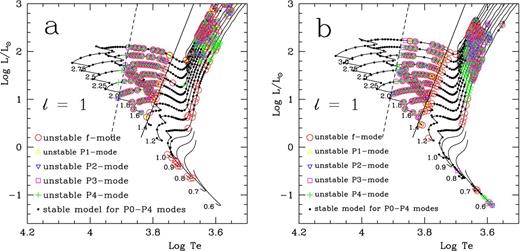
H–R diagram for instability. Pulsationally stable in F–p4 modes (small dotted) and unstable in F (circles), p1 (open triangles), p2 (open inverse triangles), p3 (open squares) and p4 (plus signs) on the evolutionary tracks calculated for M = 0.6–3.0 Mȯ. Panel (a): models in complete anisotropic equilibrium models; Panel (b): models in quasi-anisotropic equilibrium models. The dashed and solid lines are, respectively, the theoretical blue and red edges of instability strip for complete anisotropic models.
4.2 Dependence of pulsation stability on the convective parameters
Many researches on stellar convection demonstrate in one way or the other that the ‘mixing-length’ used in different kinds of theories is not a fixed parameter, which varies slowly as a function of stellar parameters such as mass, luminosity and effective temperature etc. (Ludwig et al. 1999). The conventional way of calibration is to use solar observations, but the old question is still there: can it be used to stars other than the Sun? If the pulsation stability depends sensitively on the choice of the convective parameters, the results of the theoretical calculations of the pulsation stability are questionable.
In order to investigate the dependence of pulsation instability on convection parameters, we use different combinations of convection parameters in Table 1 for linear non-adiabatic calculations (series b–f). The results of theoretical stability analysis in g9–p5 modes for an M = 18. Mȯ star using all the parameter combinations in Table 1 (series a–f) in evolutionary stages between MS until red giant branch (log Te > 3.70) are presented in the six panels of Fig. 7. In all the panels of Fig. 7, the horizontal axis is stellar effective temperature (log Te), and the vertical axis is the radial orders of oscillation modes (nr runs in between −9 and 5, correspond to g9–p5 modes), the horizontal thin solid line on each panel is f mode (nr = 0), above which are all p modes, and below g modes. The small dots denote all stable models, whose amplitude growth rates are negative (η = −2πωi/ωr < 0), where ωi and ωr are, respectively, the imaginary and real parts of the complex frequency of oscillations (ω = iωi + ωr); whereas the circles are the pulsationally unstable models, whose size is proportional to log η. It is clear from Figs 7(a) and (b) that if one compares the models in series ‘a’ and ‘b’, all the p-modes are nearly identical, and the g-modes are different but similar. This again demonstrates that the quasi-anisotropic approximation is a good approach.
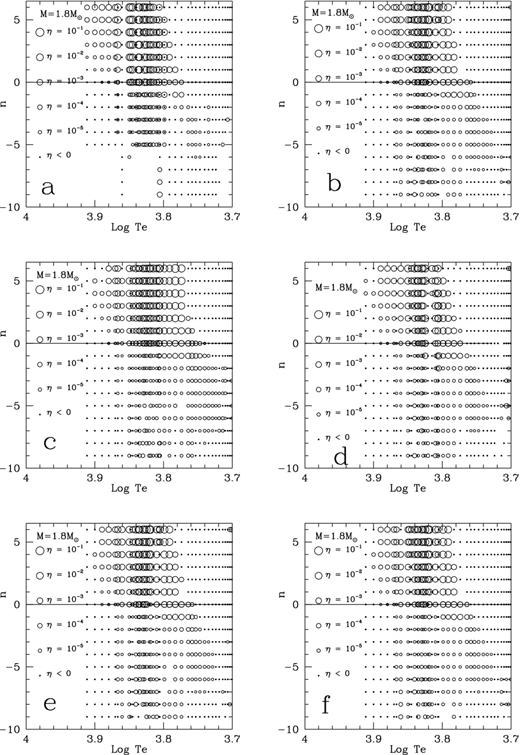
Pulsationally stable (small dots) and unstable (circles) modes in n–log Te plane for models along the evolutionary track of a M = 1.8 Mȯ star. n is the radial order of oscillation and Te is the effective temperature of the stellar model. Panel (a): the anisotropic equilibrium model; Panels (b)–(f): the quasi-anisotropic models with parameters given in Table 1, see the text for details.
Models in ‘b–d’ series are all calculated using quasi-anisotropic convection having the same c2/c1 = 0.5 and c3 = 3, but different c1. As presented in Figs 7(b)–(d) that the three sets of results are extremely close to each other. Although c1 varies by 30 per cent in these models, the red-edges of the pulsational instability trip is shifted to high temperatures by only 5 per cent (Δlog Tred ∼ 0.02) when c1 goes from 0.60 to 0.78.
Figs 7(b), (e) and (f) represent three types of quasi-anisotropic convection models that possess the same c1 and c2 (c1 = 2c2 = 0.70) but different c3 varying from 2 to 5. The degree of anisotropy in such a range of c3 changes greatly, with the rms turbulent velocity ratio, |$\overline{w^{\prime 2}_r}/\overline{w^{\prime 2}_h}\approx \left(3+c_3\right)/2c_3$|, changes from 1.25 to 0.8. However, the pulsation stability does not respond sizably in such a large variation range of c3, this implies that the pulsation stability does not depend, at least not sensitively, on the choice of parameter of anisotropy c3.
5 SUMMARY AND CONCLUSIONS
In this paper, we present a dynamic theory for complete non-local and anisotropic stellar convection, and the computational results on the structure of stellar envelope structure and non-adiabatic oscillations based on such a theory. This work can be summarized in the following.
Starting from the first principle of hydrodynamic equations and applying Reynold's decomposition for turbulence, we established a set of dynamic equations for mean fluid, and that of auto- and cross-correlations of turbulent velocity and temperature fluctuations. Following the theory of turbulence, we have introduced a proper way to deal with dissipation, diffusion and anisotropy of turbulent convection. A self-consistent and closed formalism of turbulent convection is developed, which is ready for the calculations of stellar structure and oscillations.
Three convection parameters (c1, c2, and c3) are included in the theory, which are, respectively, connected to dissipation, diffusion and anisotropy of turbulent convection in stars.
Discussions were made on the calculations of the equilibrium envelope model and the calibration of the convective parameters. Numerical experiments suggested that (c1, c2, c3) = (0.64, 1/2, 3) is a robust choice, which has been justified by a number of relevant observational facts including: the predicted structure of solar convective envelope that agrees with solar seismic inversion, the structures of atmospheric turbulent velocity and temperature fields of the Sun that match solar observations, and the depletions of lithium in the Sun and solar-type stars.
When the anisotropy of turbulent velocity and overshooting mixing in stars are not the major concerns, isotropic treatment of convection is a fairly good approximation that gives good enough T − P structure of stars. Only two parameters c1 and c2 are required in the theory. Our results show that (c1, c2) = (0.70, 0.35) is a good set. The quasi-anisotropy approximation (equation 47) can deliver very good measurements of the anisotropic component χ11 for turbulent convection, therefore can be used for linear non-adiabatic oscillation analysis for the sake of computational effort.
The theory can be used to study both radial and non-radial oscillations of stars, and it handle both thermodynamic and dynamic couplings between convection and oscillations.
Using the scheme of non-adiabatic oscillations in the non-local and time-dependent convection theory, we have done linear stability analysis of low degree (l = 1–4) g9–p29 modes for stars with M = 0.6–3.0 Mȯ from MS to red giant branch, and up to asymptotic giant branch phase. Theoretical calculations clearly show two separate δ Scuti and Mira-like instability strips in the Hertzsprung-Russell diagram. For future work, we will carry out further theoretical analysis of δ Scuti and γ Doradus stars and pulsating red giant stars, and compare the results with observations.
The dependence of pulsation stability of stars on the convection parameters (c1, c2, c3) was studied very carefully. The results show that, the stability of oscillations has only weak response to the choice of the three convection parameters within a rather wide range.
ACKNOWLEDGEMENTS
This work is supported by National Natural Science Foundation of China (NSFC) through grants 11373069, 11473037 and 11403039.



